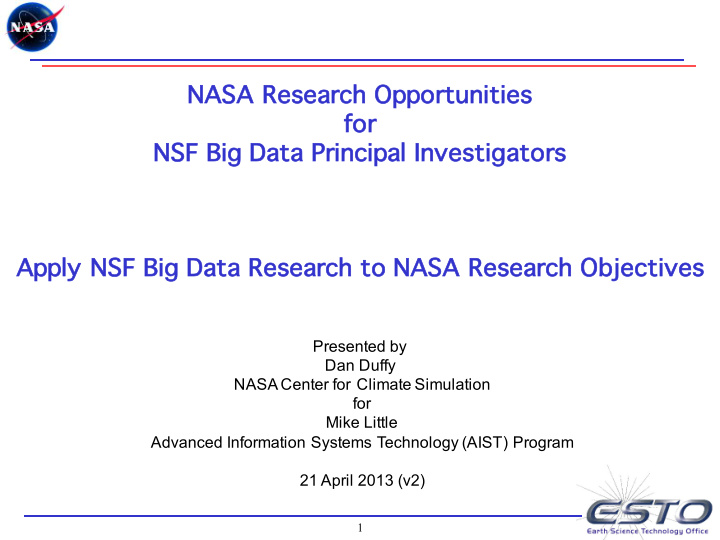



NA NASA Research O h Opportuni unities fo for NS NSF B Big Data Pr Princ ncipal I Inv nvestigators Appl Apply NSF Big Data Research to NAS ASA A Research Objectives Presented by Dan Duffy NASA Center for Climate Simulation for Mike Little Advanced Information Systems Technology (AIST) Program 21 April 2013 (v2) 1
Re Representative ve NASA SA Big Data Prob oblem Project Goal • Using National Geospatial Agency (NGA) data to estimate tree and bush biomass over the entire arid and semi-arid zone on the south side of the Sahara Project Summary • Estimate carbon stored in trees and bushes in arid and semi-arid south Sahara • Establish carbon baseline for later research on expected CO 2 uptake on the Tree Crown south side of the Sahara Principal Investigators Approximately 120 TB of Dr. Compton J. Tucker, NASA Goddard • NGA 40 cm imagery Space Flight Center representing tree & shrub Dr. Paul Morin, University of Minnesota • automated recognition Dr. Tsengdar Lee, NASA HQ • Reference: Tucker and Morin are extending earlier tree and bush mapping work published by Gonzalez, Tucker, and Sy entitled “Tree density and species decline in the African Sahel attributable to climate” in the Journal of Arid Environments in 2012. 2
HPC Big Data Example HP Takes in small input and creates large output •Using relatively small amount of observation data, models are run to generate forecasts Model Obs •Fortran, Message Passing Interface (MPI), (Many 100K Data large shared parallel file systems lines of code) •Rigid environment – users adhere to the HPC systems 10-km GEOS-5 meso-scale simulation for Observing System Simulation Experiments( OSSEs) Example: GEOS-5 Nature Run (GMAO) . 2-year Nature Run at 7.5 KM resolution • 3-month Nature Run at 3.5 KM resolution • Will generate about 4 PB of data • (compressed) To be used for Observing System • Simulation Experiments (OSSE’s) All data to be publically accessible via FTP • The Goddard Chemistry Aerosol Radiation and Transport (GOCART) model, Courtesy of Dr. Bill Putman, Global Modeling and Assimilation Office (GMAO), NASA Goddard Space Flight Center. 3 3
Av Available Data Sets • Too many to list • Result of Google search for “NASA Data” – About 248,000,000 results (0.28 seconds) • Some Resources – NASA Data Portal – NASA Earth Exchange (NEX) – Earth Data (EOSDIS) – Goddard Earth Sciences Data and Information Services Center 4
NA NASA Research A h Anno nnounc uncement nts • NASA Research Competitions Managed through NSPIRES system – https://nspires.nasaprs.com/external/ – Amendments provide individual Program announcements when released • Space Technology Mission Directorate (STMD) – Space Technology Research, Development, Demonstration, and Infusion-2016 (SpaceTech REDDI) – Open annually Oct 01, 2015 through Sep 30, 2016 • Science Mission Directorate (SMD) – Research Opportunities in Earth and Space Science (ROSES) • Earth Science – Appendix A.1 • Heliophysics – Appendix B.1 • Planetary – Appendix C.1 • Astrophysics – Appendix D.1 – Open annually Feb 19, 2016 through April 28, 2017 – Further background • http://science.nasa.gov/researchers/sara/grant-solicitations/ • http://soma.larc.nasa.gov/ 5
Advanced Adv d Informa mation Systems ms Technology (AI AIST) • AIST Objectives (5-20 year timeframe for adoption) – Reduce the risk, cost, size, and development time of Earth Science Division (ESD) space-based and ground-based information systems; – Increase the accessibility and utility of science data; and – Enable new observation measurements and information products. • Working with NSF in an informal collaboration to encourage application of basic research to solve NASA Earth Science technology problems • Earth Science Information Partners (ESIP) Federation Testbed • Independent multi-organization evaluation of AIST Projects • NSF Earthcube Integration & Test Environment (ECITE) Program Assessment • Partnering with open source and ESRI’s ArcGIS to accelerate science • AIST-14 awarded 24 Projects totaling $25M for 2 years of work • Current schedule leads to start work in late Spring to early Summer 2017 – Draft AIST-16 Solicitation release April, 2016 for comment by June 1, 2016 – Final Solicitation release September, 2016 and proposals December 1, 2016 – Announcement in Spring, 2017 with work to start soon afterwards (2 years) 6
Re Research Needs for or AIST ST-16 16 • Automation is the key to handling large volumes of Earth Science Data – Encourage science derived from 1000’s of events instead of 2-3 selected examples • Information Life-cycle Phases – Flight Computing and Mission Management (planning & ops) Technologies • Science from sensor webs of smallsat/cubesats, in situ and airborne instruments – Data Exploitation • Data-driven modeling: validation and near real-time updating tools/techniques • Multi-sensor data fusion, uncertainty analysis overlaid on GIS tools • Relevance: – Observing, understanding and reacting to the impacts of Climate Change • Biodiversity and ecological forecasting (ROSES15-A.6) • Effective Disaster Response with NASA (and other) assets and sources – Transient/transitional phenomena • Cryosphere, oceans, atmosphere, land surface, solid earth • Special Considerations – Encouraging inclusion of Earth Science team member to demonstrate value to NASA – Limited to Technology Readiness Level (TRL) 2-6: Concept through Demonstration – Encouraging multi-site and multi-disciplinary collaborations 7
Re Releva vant Re Reference Materials • ESTO (and AIST) Website: https://esto.nasa.gov/ – Further info on past projects from “Blue Button” on middle left side of screen • Data Lifecycle Framework Study http://ieee-bigdata-earthscience.jpl.nasa.gov/references/aist-big-data-study-draft-summer- 2015/view • NASA Guidebook for Proposers: http://www.hq.nasa.gov/office/procurement/nraguidebook/ • ESIP Federation Website: http://www.esipfed.org/ • Current AIST Program Overview https://esto.nasa.gov/files/2016AISTprojects_DataLifeCycle.pdf • Previous AIST-14 Announcement – https://nspires.nasaprs.com/external/solicitations/summary.do?method=init&solId={ED1 31A2F-99C8-652D-FDAA-711D580EF045}&path=closedPast • AIST Program Manager: michael.m.little@nasa.gov 8
Recommend
More recommend